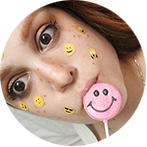







Welcome Back
Sign in to be closer to your community!
Follow other divas, like and comment
on their posts, message them, and see
who loved your posts!
Invalid username or password
You have not verified your account by clicking on the link we sent you via email. Please check your email folders (including your Spam folder) and click on the verify link sent.
Email is required
Password is required








Join FashionPotluck.com
Create your own profile in order to create content, follow other divas and like their posts, use our own messenger, and be a part of a growing international women community!
WELCOME TO OUR COMMUNITY
Fashion Potluck -
the first social media
platform for women.
You are free to read/watch & create content,
express your true self, and interact with others.
Join for free
Already a member? Log in here.
Purchase Alert
Dear Queen, you can only buy from one seller at the time. Please finish this purchase first in order to buy from another FP member
Comments
Please select one platform to continue
Please select one platform to continue
Please select one platform to continue
Please select one platform to continue
Please select one platform to continue
Please select one platform to continue
Please select one platform to continue
Please select one platform to continue
EDITOR APPROVED
You are wondering what is this 'Editor Approved'?
Well, this is pretty awesome! In order for the post to qualify and receive this accolade, it has to have a minimum of 700 words and two images (at least one original).
Receiving this accolade means two things: 1) Your content is amazing! Good job! 2) Your content qualifies for our monetization program. Every week two of the most read posts receive monetary rewards.
Have the badge & want to monetize your content?

FP-BLOG


The 1st of December marks the World AIDS Day worldwide and this is a good opportunity to show support to people infected by it, commemorate the ones who lost their lives and fight against it.
World AIDS Day is the first global health day ever, and its purpose is to educate ourselves and raise awareness of AIDS.
What are HIV and AIDS?
HIV, or human immunodeficiency virus, is the virus that causes HIV infection. The virus attacks our immune system and our body’s natural defense against illnesses. The virus destroys the so-called T-helper cells, which are white blood cells in the immune system. The T-helper cells are also referred to as the CD4 cells. As HIV destroys them and makes more copies of itself, it gradually weakens the body’s immune system.
AIDS, on the other side, is a set of symptoms and illnesses that develop as a result of advanced HIV infection which has destroyed the immune system. This is the last stage of HIV, when the infection is very advanced, and if left untreated will lead to death.
Globally, there are an estimated 36.7 million people who have the virus. The virus was first identified in 1959 but was not diagnosed until 1984.
77.3 million people have become infected, and more than 35 million people have died from AIDS-related illnesses
There are at least 1.15 million people living with AIDS in the US, which has the highest number of AIDS patients in the developed world.
Around 1 in 7 people living with HIV are unaware they are living with the virus, as it can take up to 10 years after exposure for any symptoms to appear.
Regular testing is extremely important for diagnosis and around 59% of people living with the virus have access to treatment.
The first drug to prevent HIV transmission was only approved by the FDA in 2012, but it can reduce the risk of HIV for 75%.
IN 2017, 1.8 milion people became newly infected with HIV. Since a peak in 2004, deaths from AIDS have decreased
Why are people not getting tested?
People do not want to get tested for HIV for multiple reasons. One of the prevailing ones is the social stigma associated with it, as people feel they will be rejected by the community. However, not testing yourself will just worsen the situation and won’t bring any good. People might think they are not at risk of being infected as they are having a monogamous relationship and are using protection. However, it is important to know that there are multiple ways of transmitting HIV.
HIV is spread through contact with certain body fluids from a person with HIV. These body fluids include semen, blood, vaginal, pre-seminal and anal fluids, and breastmilk. HIV can’t be transmitted through sweat, saliva or urine. HIV is mostly transmitted by having vaginal/anal sex with someone who has HIV without using condoms/taking medicines to prevent or treat HIV. Another way is through sharing injection drug equipment such as needles with someone who is infected by the virus.
Reducing the risk of an HIV infection is done using protection while having sex, never sharing injection drug equipment with others and limiting the number of sexual partners. Consult this Risk Reduction Tool to learn how safe you are.
What happens if you don’t get treatment?
If not treated, the immune system will become so weak until it can no longer fight life-threatening infections and diseases. Depending on age, general health and background, the rate at which HIV progresses vary per person. If left untreated, it may take up to 10 or 15 years for the immune system to be so badly damaged it can’t any longer defend itself at all.
An early diagnosis and start of treatment mean the patient can enjoy better health in long-term.
ART, or Antiretroviral therapy is used for treatment and is recommended for everyone who has HIV. ART can’t cure the HIV infection but can help people live longer, healthier lives reducing the level of HIV. There is no cure for HIV, but with the right treatment and support can create a big change. To learn more about the symptoms of the virus, visit Explaining HIV and AIDS.
Find more information here:
HIV- AIDS: Symptoms and Causes
To find a location to get tested, go to GET TESTED
Find if you should get tested and more info about testing here.
How can you show support for the AIDS international Day 2018?
You can show solidarity by wearing a red ribbon, which marks fighting against AIDS. You can purchase your ribbon from the online store. Spreading your knowledge and awareness with other people in your surrounding is extremely important.
Check this online event locator to find out which events are organized in your area. You can donate to the National AIDS Trust here.
Finally, remember to get tested against HIV at least once, share your knowledge with your community, and show compassion to people affected by it! xx
Comments
Related Posts
- What Makes Men’s Accessories Worth Investing In Today? by Ekim Fashion 0
- How to Plan Seasonal Plush Inventory Without Overbuying by Harnel Inc 0
- 6 Winter Season Reasons to See a Dermatologist ASAP by Monica Quinn 0
More Posts
- Affordable Embroidery Services | Free Design Assistance by Embroidery Designs 0
- Beyond the Hardwood: Finding the Fun in Absurd Physics Games like Basket Random by Suzanna Brown 0
- Why Cowboy Ties Are Making a Bold Fashion Comeback This Year by Rocky Mountain Western 0
Vote content out
Reason for voting this content out?
Reason for voting this content out?


 Login with Google
Login with Google Login with Twitter
Login with Twitter







 by
by 




Add Comments